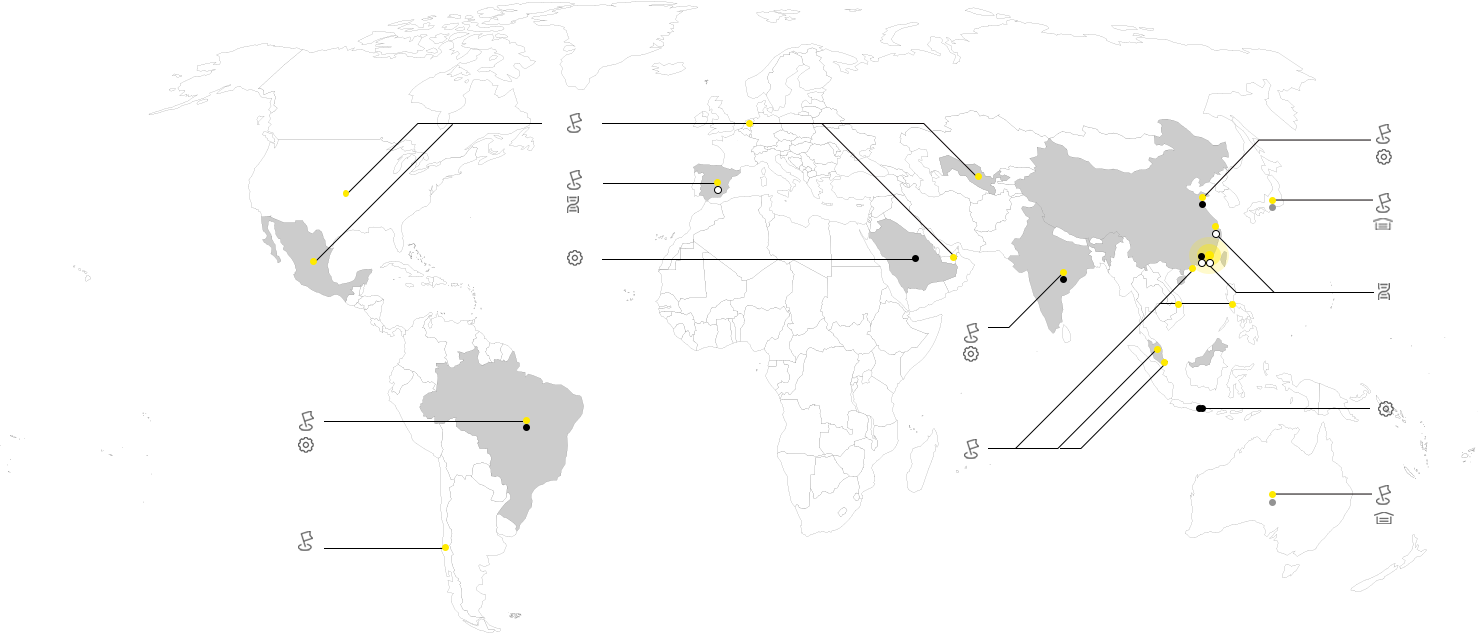全球布局
凭借全球化的业务布局,安泰新能源已在上海、澳大利亚、日本、美国、印度、荷兰、巴西、新加坡、越南、菲律宾、马来西亚以及众多其他国家和地区设立了分公司、子公司及办事处。而且,安泰新能源在中国、东南亚、南亚、中东、欧洲和拉美地区设立六个制造基地。凭借核心技术赋予产品的高性能、持续的研发投入以及全方位的优质服务。





September 23, 2024
安泰新能源荣登“省级制造业单项冠军企业”榜单,彰显领军制造实力
September 13, 2024
安泰新能源再度登榜“全球新能源企业500强”,并入选“2024碳科技创新典型案例”
September 10, 2024
安泰新能源携手SAP与TransInfo,加速企业转型打造“数智安泰”
July 30, 2024
标普权威发布,安泰新能源多项全球前十,跻身世界一线跟踪支架厂商行列
June 16, 2025
高光合辑|2025 SNEC 安泰新能源引领绿色科技风潮
June 09, 2025
全球跟踪支架TOP9!安泰新能源强势登榜Wood Mackenzie,领跑多国市场!
March 11, 2025
安泰新能源发布《2024 年度社会责任报告》
October 09, 2024
权威认可!安泰新能源荣获澳大利亚EUPD“顶级光伏品牌”荣誉
September 23, 2024
安泰新能源荣登“省级制造业单项冠军企业”榜单,彰显领军制造实力
September 13, 2024
安泰新能源再度登榜“全球新能源企业500强”,并入选“2024碳科技创新典型案例”
September 10, 2024
安泰新能源携手SAP与TransInfo,加速企业转型打造“数智安泰”
July 30, 2024
标普权威发布,安泰新能源多项全球前十,跻身世界一线跟踪支架厂商行列
June 16, 2025
高光合辑|2025 SNEC 安泰新能源引领绿色科技风潮
June 09, 2025
全球跟踪支架TOP9!安泰新能源强势登榜Wood Mackenzie,领跑多国市场!
March 11, 2025
安泰新能源发布《2024 年度社会责任报告》
October 09, 2024
权威认可!安泰新能源荣获澳大利亚EUPD“顶级光伏品牌”荣誉
1 / 8
April 13, 2023
助千年丝路换“新绿”,安泰新能源60MW大型地面项目落地酒泉
February 06, 2023
开门红!安泰新能源拿下巴西187MW跟踪支架项目!
January 10, 2023
4MW+6MWH,福建省首个工业光储一体项目签约仪式圆满举行!
December 27, 2022
13MW“BIPV+养殖”一体化生态牧场稳步推进!安泰新能源「泰阳顶」助力乡村绿色发展
October 08, 2024
372MW跟踪支架项目重磅签约!印度市场又一里程碑!安泰新能源与Hild Energy达成合作
August 28, 2024
印度10MW光伏跟踪项目成功落地,安泰新能源助力印度清洁能源可持续发展
April 03, 2024
拉美市场新突破,安泰新能源斩获危地马拉42MW光伏电站项目
August 14, 2023
大动作!安泰新能源斩获乌兹别克斯坦470MW光伏跟踪项目
April 13, 2023
助千年丝路换“新绿”,安泰新能源60MW大型地面项目落地酒泉
February 06, 2023
开门红!安泰新能源拿下巴西187MW跟踪支架项目!
January 10, 2023
4MW+6MWH,福建省首个工业光储一体项目签约仪式圆满举行!
December 27, 2022
13MW“BIPV+养殖”一体化生态牧场稳步推进!安泰新能源「泰阳顶」助力乡村绿色发展
October 08, 2024
372MW跟踪支架项目重磅签约!印度市场又一里程碑!安泰新能源与Hild Energy达成合作
August 28, 2024
印度10MW光伏跟踪项目成功落地,安泰新能源助力印度清洁能源可持续发展
April 03, 2024
拉美市场新突破,安泰新能源斩获危地马拉42MW光伏电站项目
August 14, 2023
大动作!安泰新能源斩获乌兹别克斯坦470MW光伏跟踪项目
1 / 8
July 19, 2024
助力东盟可持续未来,安泰新能源2024东南亚之旅收获颇丰
June 25, 2024
安泰新能源 Intersolar 2024 圆满收官!撑起绿能世界
June 21, 2024
撑起绿能世界,安泰新能源 2024 SNEC 精彩高光锦集
June 21, 2024
超1GW!安泰新能源与L&T、MATGROW、SCG和CINCO等公司签署多个国际项目,共创绿能世界!
June 06, 2025
展会预告|2025 SNEC 绿能之风 穿行上海
May 16, 2025
安泰新能源在 2025 年欧洲国际太阳能展上展示全场景光伏支架解决方案,并签订 120 兆瓦分销合同
October 28, 2024
安泰新能源全场景支架解决方案亮相All Energy 2024,助力澳洲清洁能源发展
October 21, 2024
安泰新能源亮相沙特展,引领光伏新未来
July 19, 2024
助力东盟可持续未来,安泰新能源2024东南亚之旅收获颇丰
June 25, 2024
安泰新能源 Intersolar 2024 圆满收官!撑起绿能世界
June 21, 2024
撑起绿能世界,安泰新能源 2024 SNEC 精彩高光锦集
June 21, 2024
超1GW!安泰新能源与L&T、MATGROW、SCG和CINCO等公司签署多个国际项目,共创绿能世界!
June 06, 2025
展会预告|2025 SNEC 绿能之风 穿行上海
May 16, 2025
安泰新能源在 2025 年欧洲国际太阳能展上展示全场景光伏支架解决方案,并签订 120 兆瓦分销合同
October 28, 2024
安泰新能源全场景支架解决方案亮相All Energy 2024,助力澳洲清洁能源发展
October 21, 2024
安泰新能源亮相沙特展,引领光伏新未来
1 / 8
July 06, 2021
“整县推进”号列车已发车,安泰新能源邀您开启分布式低碳之旅
April 23, 2021
习近平:中国将严控煤电项目,启动全国碳市场上线交易
March 15, 2021
大功率时代,安泰新能源跟踪支架如何适配210组件?
March 15, 2021
跟踪支架的春天来了!
October 28, 2021
国务院印发《2030年前碳达峰行动方案》,全面推进风电、太阳能发电大规模开发和高质量发展
August 02, 2021
因“顶”制宜——安泰新能源整县推进完美样本来了!
July 06, 2021
“整县推进”号列车已发车,安泰新能源邀您开启分布式低碳之旅
April 23, 2021
习近平:中国将严控煤电项目,启动全国碳市场上线交易
March 15, 2021
大功率时代,安泰新能源跟踪支架如何适配210组件?
March 15, 2021
跟踪支架的春天来了!
October 28, 2021
国务院印发《2030年前碳达峰行动方案》,全面推进风电、太阳能发电大规模开发和高质量发展
August 02, 2021
因“顶”制宜——安泰新能源整县推进完美样本来了!
July 06, 2021
“整县推进”号列车已发车,安泰新能源邀您开启分布式低碳之旅
April 23, 2021
习近平:中国将严控煤电项目,启动全国碳市场上线交易
1 / 6
June 07, 2023
安泰新能源2021年度企业温室气体排放报告
June 07, 2023
安泰新能源2021年度社会责任报告
March 14, 2022
安泰新能源关于与中信博知识产权侵权纠纷结果的公告:安泰新能源不构成侵权!
January 06, 2021
安泰新能源吉祥物Flash来啦!
April 02, 2025
安泰新能源《安泰供应商行为准则》
August 09, 2024
安泰3.0光伏跟踪系统一站式解决方案白皮书
August 09, 2023
安泰新能源2022年度社会责任报告
June 07, 2023
安泰新能源2021年度碳排放核查报告
June 07, 2023
安泰新能源2021年度企业温室气体排放报告
June 07, 2023
安泰新能源2021年度社会责任报告
March 14, 2022
安泰新能源关于与中信博知识产权侵权纠纷结果的公告:安泰新能源不构成侵权!
January 06, 2021
安泰新能源吉祥物Flash来啦!
April 02, 2025
安泰新能源《安泰供应商行为准则》
August 09, 2024
安泰3.0光伏跟踪系统一站式解决方案白皮书
August 09, 2023
安泰新能源2022年度社会责任报告
June 07, 2023
安泰新能源2021年度碳排放核查报告
1 / 8
GetstartedwithAntaisolar
-
福建省厦门市思明区环岛东路1801号中航紫金广场A塔30楼
-
+86-592-5902515
-
sales@antaisolar.com
Subscribe To Our Newsletter
Please read on, stay posted, subscribe
and we welcome you to tell us what you think















